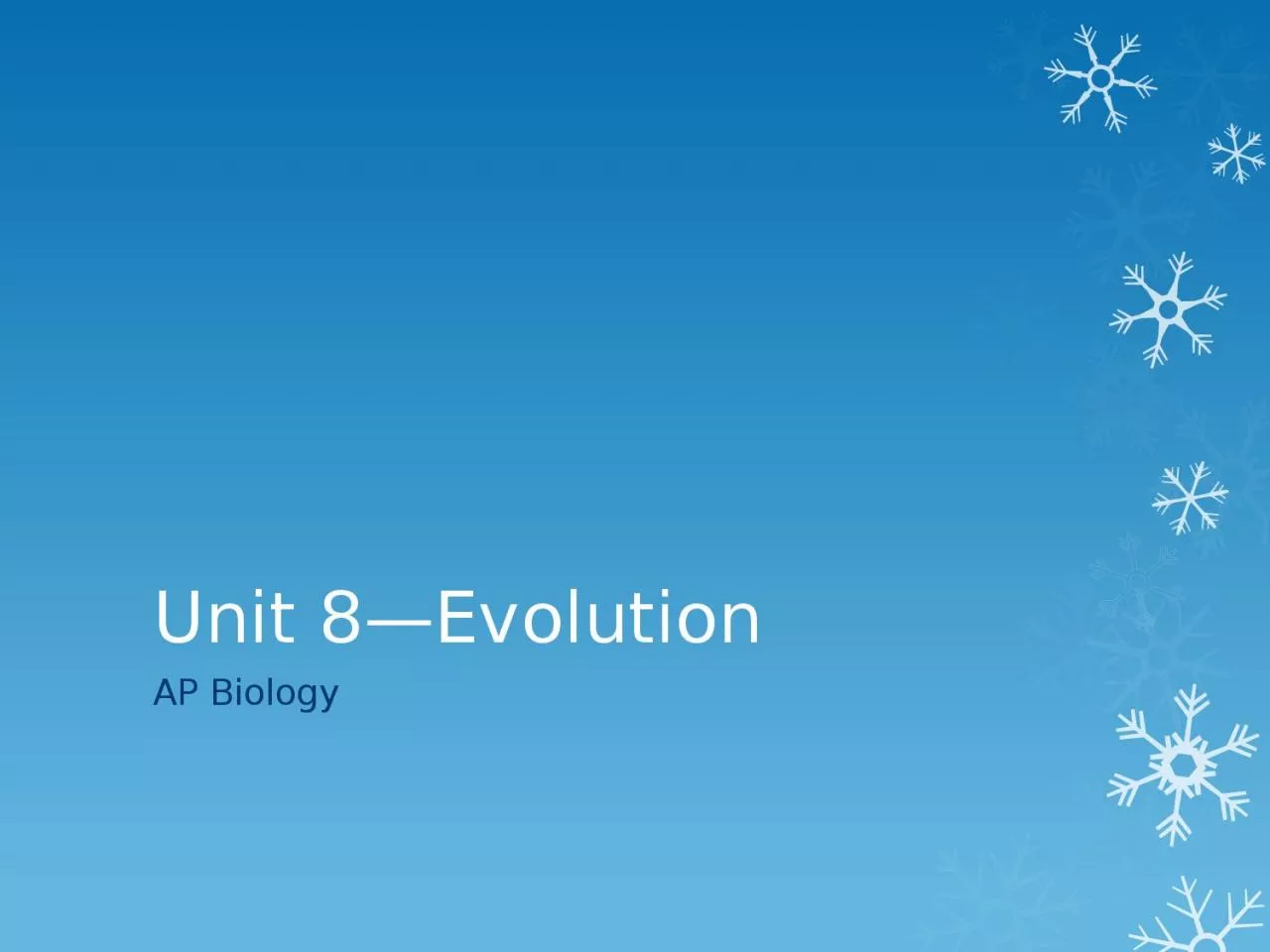

I Evolution and Evolutionary Evolutionchange in gene frequency in a population over time Change must be genetic Occurs in a populationnot individuals Time depends on how fast environment changes and how fast organisms reproduce ID: 917513
Download Presentation The PPT/PDF document "Unit 8—Evolution AP Biology" is the property of its rightful owner. Permission is granted to download and print the materials on this web site for personal, non-commercial use only, and to display it on your personal computer provided you do not modify the materials and that you retain all copyright notices contained in the materials. By downloading content from our website, you accept the terms of this agreement.
Slide1
Unit 8—Evolution
AP Biology
Slide2I. Evolution and Evolutionary
Evolution—change in gene frequency in a population over time
Change must be genetic
Occurs in a population—not individuals
Time depends on how fast environment changes and how fast organisms reproduce
Evolutionary Theory—diversity of organisms on earth is due to evolution from simple to complex
Slide3II. Hypotheses about Origins of Life
Resources for these notes
Bozeman Video—
Abiogenesis
http://www.bozemanscience.com/010-abiogenesis
Campbell Textbook—
Ch. 25.1
Ch. 25.3
Slide4II. Hypotheses about Origins of Life
Spontaneous Generation—thought that life could form from non-living things
1862—Pasteur disproved this idea through is experiments
Slide5II. Hypotheses about Origins of Life
Organic Molecules—Building Blocks of Life
1
st
Organic Molecules made in lab—Miller-Urey 1953
Early earth—reducing environment
Energy—from lightning, UV,…(no ozone yet)
Experiments with these conditions created amino acids (abundantly)…also sugars, lipids, & nitrogenous bases
Slide6II. Hypotheses about Origins of Life
Polymerization—putting pieces together to make macromolecules!
Researchers have made polypeptides without enzymes.
Dehydration by vaporization—drip amino acids on hot sand, clay or rock
Slide7II. Hypotheses about Origins of Life
Membranes—lipids spontaneously form spheres—enclose liquids and form a membrane (
Protobionts
/
Protocells
)
Slide8II. Hypotheses about Origins of Life
1
st
Genetic Material
Life needs replication and replicating molecules
1
st
genes were RNA—which can replicate (“RNA World”)Ribozymes—RNA catalysts—assembled amino acids and replicated RNA (no enzymes or ribosomes yet)
Slide9II. Origins of Life
Prokaryotic
Cells
—First Fossils are
apprx
. 3.5
billion
years old2 Domains—Archaea and Bacteria
2 Hypothesis about how they got their energy
Took ATP from environment
Made ATP from sulfur and iron
Slide10II. Origins of Life
First fossils are
apprx
. 2.1 billion years old
Membrane enfolding
and
Endosymbiosis
(Review!)
D.
Eukaryotic Cells
Slide11III. Developing Ideas about Evolution
Resources
Campbell Textbook
Ch. 22
Slide12III. Developing Ideas about Evolution
Ancient Ideas
Anaximander
– Greek; 500BC; thought perhaps simple things developed into more complex forms
Aristotle
—Greek; 384-322BC; believed that species are “fixed”; created separately and could not be changed
Other cultures
—
e
ach culture had an explanation (varied)
Slide13III. Developing Ideas about Evolution
B. Mid-1700’s– Geology presented several big ideas…
Earth is older than 6000 years
old
Early 1800—
Lyell
—Principals of Geology—gradual forces shape the earth rather than
catastrophesCollections of fossils—found ocean fossils on mountain tops—perplexed scientists
…
Sir Charles Lyell
Slide14III. Developing Ideas about Evolution
Lamarck/Wallace
Lamarck
-Published essay in 1809
“Inheritance of Acquired Characteristics”-changed due to use/disuse and developed traits could be passed on…
Wallace
-Published essay in 1858
Natural selection-slow modification-
didn’t apply to humans
Alfred Wallace
Jean
Baptiste
-Lamarck
Slide15III. Developing Ideas about Evolution
D.
Darwin
—Wrote essay in 1844 but published it in 1858
Darwin’s Voyage—HMS
Beagle
1831-1836—Some observations made on the voyage
Similar adaptations occurred in similar environments
Great diversity within the same environment (ex. Galapagos finches)
Fossils—Darwin developed a large collection
Slide16III. Developing Ideas about Evolution
Charles Darwin and HMS Beagle Voyage
Slide17III. Developing Ideas about Evolution
Darwin’s Explanation—Decent
with Modification
Did not use the term evolution
No supernatural—all based upon what was seen in the natural world
Developed ideas while on HMS Beagle—highly influenced by Malthus, Lyell, and other scientists
Basic idea was that organisms change over time…main mechanism is natural selection…particularly for adaptive change
Slide18III. Developing Ideas about Evolution
Timeline of Scientific Ideas about Geology, Inheritance, Evolution, and Population Limits
Slide19IV. Natural Selection and Artificial Selection
Resources
Bozeman—Natural Selection
http://www.bozemanscience.com/001-natural-selection
Campbell Textbook
Ch. 23
Learn Genetics
http://learn.genetics.utah.edu/content/selection/artificial/
Slide20IV. Natural Selection and Artificial Selection
Natural Selection
–organisms with certain inherited traits tend to survive and
reproduce
at higher rates in their
environment
than other individuals because of those traits.
Differential Reproduction
—organisms overproduce -> not all survive -> those better suited for environment survive -> Reproduce more
Reproduction is what matters—ensures passing on of genes
“Better suited” to survive, not “best”… really survival of the good enough…
Conditions of environment determine if fit enough
Slide21IV. Natural Selection and Artificial Selection
Adaptation
—genetic trait that helps an organism reproduce
(variations sometimes turn into adaptations, but not always)
Relative Fitness
—the contribution an individual makes to the gene pool of the next generation relative to the contributions of other individuals
**Likelihood of reproducing and passing on genes
Slide22IV. Natural Selection and Artificial Selection
Slide23IV. Natural Selection and Artificial Selection
Artificial Selection– humans determine who reproduces
Can create more change in short period of time
May create artificial environment for artificially selected organisms to survive